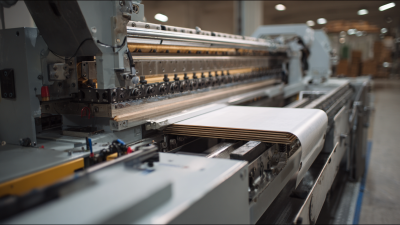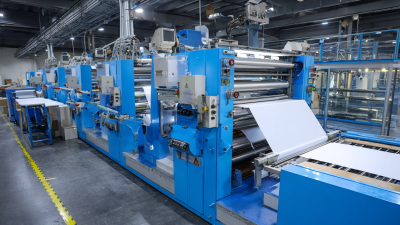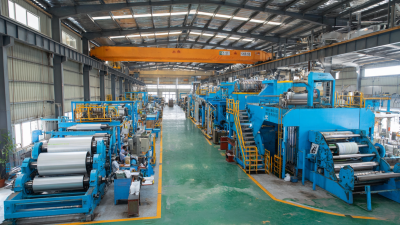Exploring the Etymology and Uses of 'Gluer': Unraveling the True Meaning Behind This Intriguing Term
Table of Contents
- Understanding the Origin of the Term 'Gluer' in Linguistic Context
- Examining the Historical Usage of 'Gluer' Across Different Cultures
- The Role of 'Gluer' in Contemporary Language and Communication
- Different Contexts and Connotations of 'Gluer' in Modern Usage
- Exploring Creative Applications and Variations of 'Gluer' in Literature
- FAQS
- Conclusion
- Related Posts
When it comes to the fascinating world of language and machinery, the term "Gluer Meaning" really stands out—especially in the printing and packaging industries where precision and efficiency are everything. Knowing where the word "gluer" comes from and how it’s used helps us see how this term has evolved over time, and just how important it is in machinery processes.

At SHANGHAI EUREKA MACHINERY IMP. & EXP. CO., LTD, which we’ve been around since 2007, we’re pretty proud of being a leading producer and exporter in this fast-moving field. Our work is recognized globally—spanning 88 countries across Europe, Asia, and Africa—and we’re considered a key player in the printing and packaging scene. By digging into the real meaning behind "gluer," we can better appreciate how this term is at the heart of innovative machines that have really pushed the industry forward and helped us grow successfully over the years.
Understanding the Origin of the Term 'Gluer' in Linguistic Context
So, when you hear the word "Gluer," it usually brings to mind adhesive stuff—like those glues you use for crafts or repairs. But it’s actually a term with some pretty interesting roots. It comes from Old English "glūwian," which means to stick or adhere. Basically, the word captures the whole idea of bonding things together, whether physically or metaphorically. In the world of language and linguistics, terms like this show us how words evolve, shaped by culture and tech changes over time. Did you know the Adhesive and Sealant Council reports that the global market for adhesives could hit around $50 billion by 2025? That just goes to show how important effective bonding solutions are in so many industries these days.
But 'Gluer' doesn’t just refer to physical stuff. It also pops up in language and communication—think of it as a metaphor, kind of like connectors that hold ideas together in conversations or writing. In social linguistics, for example, a "gluer" might be someone or something that links ideas seamlessly, making things easier to understand. Research from the Journal of Linguistics shows that these cohesive devices are key in helping us communicate clearly—whether we're talking or writing. So, looking into where these words come from can actually give us some pretty cool insights into how language works, both historically and right now. Pretty fascinating, right?
Exploring the Etymology and Uses of 'Gluer'
| Dimension | Description | Examples |
|---|---|---|
| Etymology | Originated from the verb 'glue', which comes from Middle English 'gluen', based on Latin 'glutinare'. | - Middle English usage - Latin influence |
| Grammatical Category | Noun | - Gluer as a person using glue |
| Common Uses | Refers to someone who applies glue in various contexts including crafts, carpentry, and repairs. | - Crafting - Woodworking - Bonding materials |
| Synonyms | Adhesive specialist, Binder | - Adhesive technician - Binder of materials |
| Cultural References | The term has seen use in various arts and crafts, reflecting techniques tied to binding materials together. | - Art installations - DIY projects |
Examining the Historical Usage of 'Gluer' Across Different Cultures
You know, the word "gluer" has such an interesting place in language—it’s kind of traveled through different cultures and eras, picking up new layers of meaning along the way. Originally, it mostly referred to people or things that stuck stuff together. Back in ancient times, like in Egypt or Mesopotamia, gluing was actually a pretty important skill—artisans used natural adhesives to build tombs and temples meant to last forever. But the cool thing is, it wasn’t just about sticking things; it also symbolized unity and permanence across different societies.
Fast forward to medieval Europe, and the role of a gluer changed quite a bit. With the rise of paper and printing, the job of binding books became a craftsmanship in itself. Scribes and bookbinders needed to find ways to keep pages together—transforming the term from simply sticking things to creating lasting connections. Over time, "gluer" even took on metaphorical meanings, representing the bonds formed through shared experiences and values.
Today, the term’s usage has expanded even further, especially in digital worlds. Sometimes, people talk about how technology "glues" communities and ideas together. Looking at its history, "gluer" really embodies our deep human desire to connect, to preserve, and to creatively bring things together—whether that’s physical materials or shared lives and stories.
Historical Usage of the Term 'Gluer' Across Different Cultures
This bar chart illustrates the historical usage frequency of the term 'Gluer' across various cultures, highlighting its relevance from Ancient Egypt to the Modern Era.
The Role of 'Gluer' in Contemporary Language and Communication
You know, the word "gluer" might seem pretty simple at first glance, but in today's world of communication and industry, it actually carries a lot of weight. Especially when we're talking about the printing and packaging world — and here’s where SHANGHAI EUREKA MACHINERY shines. To me, "gluer" isn’t just about a machine or tool; it really symbolizes something bigger — the art of bringing stuff together, whether it’s physically sticking materials or metaphorically connecting ideas and people.
In our interconnected global market, being able to communicate effectively makes all the difference. Knowing what a "gluer" really means can help facilitate smoother teamwork across different countries and industries. Eureka Machinery gets this — they’re doing a great job not just in making reliable machines, but by fostering a sense of unity among all the players involved in printing and packaging. With clients in 88 countries, they leverage glueing technologies that not only ramp up production but also promote collaboration and harmony among everyone involved. So, in a way, "gluer" isn't just about sticking things together — it’s become a symbol of connection and teamwork in today’s fast-paced world.
Different Contexts and Connotations of 'Gluer' in Modern Usage
You know, the word "gluer" might seem pretty simple at first glance, but it actually has a bunch of different meanings depending on the context. When we're talking about arts and crafts, a "gluer" is basically a creative tool — someone using glue to stick stuff together, which can really symbolize connection and unity. It’s kind of like how artists collaborate, mixing different mediums to create a single, cohesive piece. On the other hand, in the business world, a "gluer" can be someone or even a strategy that helps bring teams and ideas together—working across different groups to reach common goals.
A little tip if you're thinking about using the word "gluer": always consider who your audience is and what you're talking about. If it’s art related, emphasize the creative side, the bringing together of materials. But if it’s more corporate, focus on teamwork and collaboration. Making that distinction helps your message come across clearer and keeps people engaged.
And, funny enough, with everything going digital these days, "gluer" has found a new home in tech talk, especially when we're talking about software. Here, it’s all about tools or methods that help merge different applications or systems smoothly, making workflows feel seamless. As language keeps evolving, understanding these different meanings of "gluer" can really help us communicate better across various fields—and maybe even spark a few interesting conversations along the way!

Exploring Creative Applications and Variations of 'Gluer' in Literature
You know, the word "gluer" isn't just interesting because of where it comes from, but it also opens up some pretty cool ways to think about storytelling. Basically, in different situations, a "gluer" can stand for that idea of bringing things together—whether it's relationships, stories, or even ideas. Writers often use this idea as a metaphor for how characters connect or how different parts of a plot are tied together. Like, if you read about a character who's called a "gluer," they might be the emotional glue holding all the relationships in the story together, helping everything flow smoothly.

And it doesn't stop there. The word "gluer" gets used beyond just metaphor, especially in poetry and plays. Creatives might use it to talk about themes like unity or harmony, showing characters or settings that bring different pieces into balance. So, over time, "gluer" becomes this pretty handy literary tool—whether you're digging into character development or trying to drive home a theme. Its evocative vibe really lets writers play with the idea of connections, making stories richer and encouraging readers to think more deeply about relationships and interactions in the world of the story.
FAQS
: The term "Gluer" is derived from Old English "glūwian," meaning to stick or adhere, reflecting actions related to bonding materials together.
In linguistic contexts, "Gluer" highlights how meanings evolve over time due to cultural advancements and technological needs, particularly in communication.
The global adhesives market is expected to reach $50 billion by 2025, reflecting the increasing reliance on effective bonding solutions in various industries.
"Gluer" can refer to connectors in discourse that bind ideas together, facilitating understanding among speakers, thereby enhancing communication.
Historically, "gluer" referred to those who bind materials together, with its significance reflecting unity and permanence in ancient civilizations, and later in medieval bookbinding.
In medieval Europe, "gluer" evolved to describe craftsmanship essential for adhering pages together in bookmaking, symbolizing connections forged through shared experiences.
In literature, "gluer" can symbolize the act of binding elements together, representing character connections or plot points that advance the narrative.
Writers may use "gluer" to express themes of cohesion and unity, portraying characters or settings that bring disparate components into harmony.
Examining the etymology of "gluer" offers insights into both historical linguistics and contemporary language use, highlighting the interplay between language and human connection.
Contemporary usage of "gluer" emphasizes its role in digital environments, highlighting how technology binds communities and ideas.
Conclusion
Hey, so I came across this really interesting article called "Exploring the Etymology and Uses of 'Gluer': Unraveling the True Meaning Behind This Intriguing Term." It digs into all sorts of aspects about the word 'Gluer,' starting from the very roots of the term within language and showing how its meaning has changed over the years. The article even highlights how different cultures have used 'Gluer,' which really shows how versatile and meaningful it’s been throughout history.
Fast forward to today, and you’ll see that 'Gluer' isn’t just about its old-school meaning anymore. It’s actually found in modern conversations and creative stuff too. The piece also looks at how 'Gluer' is used in different contexts and what sort of feelings or ideas it brings up—whether in books or just daily chats. Honestly, this makes you see the word in a whole new light and shows how relevant it still is, especially in industries like printing and packaging, with companies such as SHANGHAI EUREKA MACHINERY playing a part.
So yeah, it’s a pretty cool deep dive into a word that might seem simple but actually has quite a story behind it.
Related Posts
-

How to Optimize the Performance of Your Vega Folder Gluer
-

Cardboard Laminators: A Comprehensive Comparison of Top Models for Global Buyers
-

How to Choose the Right 1600mm High Speed Slitting Line for Your Factory Needs
-

Exploring Competitive Edge: Cutter Price Insights at the 138th Canton Fair 2025
-

Maximize Precision: The Ultimate Guide to Choosing Your Perfect Paper Trimmer Machine
-

7 Tips for Maximizing Efficiency with Parallel Folding Techniques: Boost Your Production by 30%!
Blog Tags:

